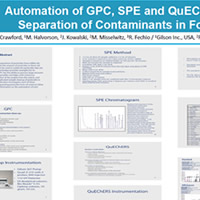
Automation of GPC, SPE and quechers separation of contaminants in food
|
Resumo do Pôster:Several techniques for the separation of targets from complex matrices are used today before the chromatographic analyses. Gel Permeation Chromatography (GPC), Solid Phase Extraction (SPE) and QuEChERS (Quick, Easy, Cheap, Effective, Rugged and Safe extraction technique) can be used for this purpose. Each technique provides strengths for the separation of targets. GPC has the ability to process large amounts of sample, SPE provides disposable cartridges with numerous sorbents to provide separation of the analyte from the matrix, and QuEChERS involves uncomplicated sample cleanup. This work investigates each of these separation techniques in separating pesticides from oil matrices (olive oil) and presents detailed information on the automation of each separation system. The GPC sample used was olive oil, 50 mg/L in dichloromethane. This was injected onto the GPC column and the fraction collected, and dried down. The SPE sample used was olive oil in hexane 50:50. This sample was extracted using Liquid Liquid Extraction (LLE) with acetonitrile (ACN). The ACN extract was placed on the SPE and eluted with ACN then dried down. The QuEChERS sample used was olive oil in hexane 50:50. This sample was extracted using LLE with ACN. The ACN extract was placed on the SPE and eluted with ACN then dried down. All dried down samples were brought up in 200 µL of hexane or ethyl acetate for injection on the GC. Twenty pesticide standards were used to construct analytical curves. Recovery of the methods was determined. The GPC method attained recoveries of >95% for all the pesticide analytes. The QuEChERS and SPE methods attained a recovery of 70% to 80%. The GPC method attained the lowest detectable limits at 3.3 times that of SPE and 10 times that of the QuEChERS extraction method. All methods attained levels of 25 µg/mL of each pesticide and extrapolated a possible low detectable limit of 5 µg/mL for QuEChERS, 1.7 µg/mL for SPE and 400 ng/mL for GPC. |
